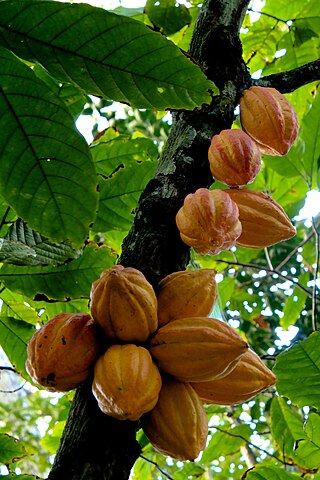
Theobroma cacao is a small evergreen tree in the family Malvaceae. Its seeds, cocoa beans, are used to make chocolate liquor, cocoa solids, cocoa butter and chocolate. Native to the tropics of the Americas, the largest producer of cocoa beans in 2018 was Ivory Coast, at 2.2 million tons. Its leaves are alternate, entire, unlobed, 10–50 cm (4–20 in) long and 5–10 cm (2–4 in) broad.

Prunus is a genus of trees and shrubs, which includes the fruits plums, cherries, peaches, nectarines, apricots, and almonds.

Petroselinum is a genus of two parsley species of flowering plants in the family Apiaceae, native to western and southern Europe and northern Africa.

Theobroma grandiflorum, commonly known as cupuaçu, also spelled cupuassu, cupuazú, cupu assu, or copoazu, is a tropical rainforest tree related to cacao. Native and common throughout the Amazon basin, it is naturally cultivated in the jungles of north of Brazil, with the largest production in Pará, Amazonas and Amapá, Colombia, Bolivia and Peru. The pulp of the cupuaçu fruit is consumed throughout Central and South America, especially in the northern states of Brazil, and is used to make ice creams, snack bars, and other products.
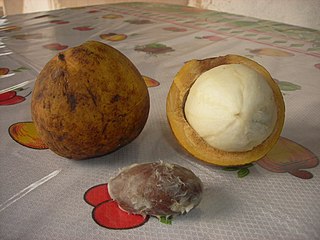
Platonia insignis, the sole species of the genus Platonia, is a tree of the family Clusiaceae native to South America in the humid forests of Brazil, Paraguay, parts of Colombia and northeast to Guyana; especially in Amazon Rainforest. Common names include bacuri, maniballi, naranjillo and bacurizeiro.
Sterculiaceae was a family of flowering plant based on the genus Sterculia. Genera formerly included in Sterculiaceae are now placed in the family Malvaceae, in the subfamilies: Byttnerioideae, Dombeyoideae, Helicteroideae and Sterculioideae.

Cauliflory is a botanical term referring to plants that flower and fruit from their main stems or woody trunks, rather than from new growth and shoots. It is rare in temperate regions but common in tropical forests.

Abroma is a genus in the family Malvaceae, with one or two species from Asia and Australia. Ambroma is an orthographic variant.
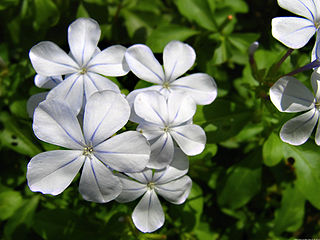
Plumbago is a genus of 10–20 species of flowering plants in the family Plumbaginaceae, native to warm temperate to tropical regions of the world. Common names include plumbago and leadwort.

Sideroxylon is a genus of trees in the family Sapotaceae described as a genus by Linnaeus in 1753. They are collectively known as bully trees. The generic name is derived from the Greek words σιδηρος (sideros), meaning "iron", and ξύλον (xylon), meaning "wood."

Moniliophthora roreri is a basidiomycete fungus that causes frosty pod rot disease, one of the most serious problems for cacao production in Latin America. This disease and together with witches’ broom disease and black pod rot constitute the cacao disease trilogy. It causes serious losses in southwestern parts of South America; spores are dry and powdery and are spread easily by water movement, wind, or movement of pods; disease spread is highest during periods of high rainfall.

Chloroleucon is a genus of flowering plants in the family Fabaceae. It contains 11 species native to the tropical Americas, ranging from Mexico through Central America, the Caribbean, and South America to northern Argentina. Some authorities consider it part of the genus Albizia. Its name is derived from the Greek words χλωρóς (chloros), meaning "green," and λευκός (leukos), meaning "white."
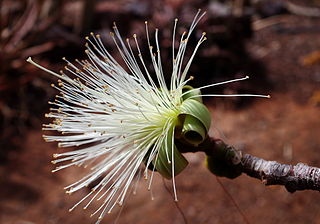
Pseudobombax is a genus of flowering plants in the subfamily Bombacoideae of the family Malvaceae.

Melia is a genus of flowering trees in the family Meliaceae. The name is derived from μελία, the Greek name used by Theophrastus for Fraxinus ornus, which has similar leaves.
The following outline is provided as an overview of and topical guide to chocolate:
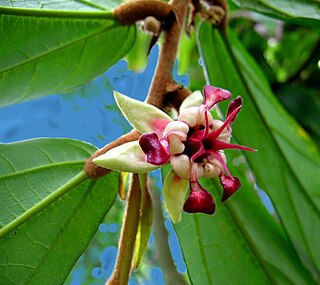
Byttnerioideae is a subfamily of the flowering plant family Malvaceae.

Theobroma bicolor, known commonly as the mocambo tree, jaguar tree, balamte, or pataxte, among various other common names, is a tree in the genus Theobroma, which also contains the better-known Theobroma cacao. It is found in Central and South America, including stretches of the Amazon rainforest in Brazil, Colombia, Ecuador, and Peru.

Hesperostipa is a genus of grasses in the family Poaceae. Members of the genus are commonly known as needle-and-thread grass or needlegrass.

Theobroma speciosum is an arboriform species of flowering plant in the mallow family native to northern South America. It is the 35th most abundant species of tree in the Amazon rainforest.

























